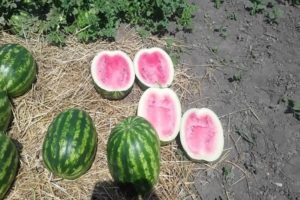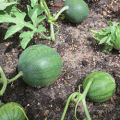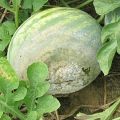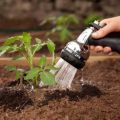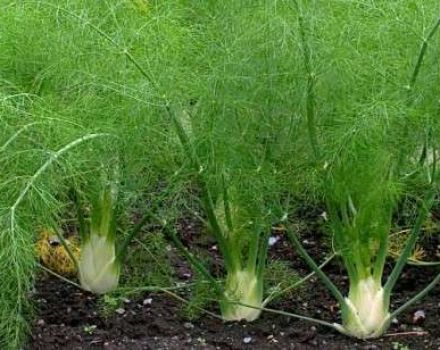How to grow watermelons in a polycarbonate greenhouse, planting and care, formation scheme
Watermelon is considered the most popular plant among melons. The main advantage of watermelons is their simplicity and ease of caring for the planted bushes. However, despite this, it is necessary to familiarize yourself in advance with the peculiarities of growing watermelons in a greenhouse in order to get a good harvest.
Benefits of growing watermelons in a greenhouse
It is no secret that the yield of melons and gourds depends on weather conditions and soil moisture. Therefore, many gardeners prefer to grow them in greenhouses. This allows you to create optimal conditions for growing watermelon bushes and independently maintain the level of soil moisture and temperature. Thanks to growing in a greenhouse, you can improve the taste of the fruit and achieve high yields. However, these are not the only advantages of using greenhouses.
Other advantages include the following:
- Protection of seedlings from late frosts. Inhabitants of the northern and central regions often experience night frosts, which halt the development of bushes and negatively affect the amount of the crop. When using polycarbonate greenhouses, you can completely protect melons and gourds from night drops in temperature.
- Moisture control. High humidity in the air or in the ground impairs the taste of watermelon berries. They become too watery and not sweet. By growing plants in greenhouse conditions, it is possible to control humidity in order to preserve the taste of the crop.
- Damage protection. Sometimes, due to mechanical damage, watermelon seedlings grow worse. To maintain the integrity of the planted shrubs, it is recommended to grow them in protected greenhouses.
Greenhouse selection and preparation
Before you start planting melons and gourds, you need to prepare a greenhouse. Large structures are suitable for planting, since watermelons are planted at a distance of at least one meter from each other. Therefore, in order to plant more than ten bushes, you will have to use a greenhouse 5 meters long and 3-4 meters wide. Also, the material from which the structure is made is determined in advance.

They are made from the following materials:
- Film. Greenhouses made of film are considered the most affordable for most gardeners. The disadvantages of film structures include the fact that they cannot be equipped with additional heating systems.Therefore, in greenhouses made of film, it is impossible to monitor the air temperature. Most often, film greenhouses are used for growing melons and gourds in early summer.
- Glass. Glass structures are the largest and heaviest. For their installation, a solid foundation is made on the site. Glass greenhouses allow the installation of a heating system for growing plants in winter.
- Polycarbonate. Polycarbonate structures are among the most expensive and reliable. Experienced gardeners recommend using them for growing watermelon bushes. They are ideal for planting in winter or spring.
The best varieties for growing in greenhouse conditions
The amount of the crop directly depends on the variety that is grown. It is recommended to select in advance the type of watermelon that is best suited for planting in greenhouses.
Siberian
Sibiryak is perfect for growing in greenhouses in northern regions. This variety was bred several years ago by the Ural breeders. The distinctive features of Sibiryak are considered its early sowing dates and the rapid ripening of watermelon fruits.
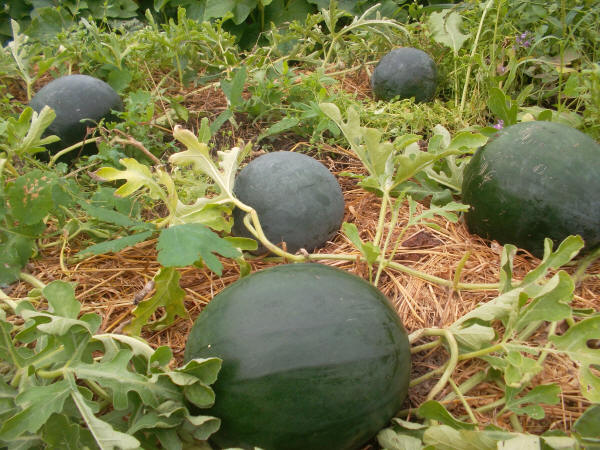
The variety grows well even in unheated greenhouses, as it is resistant to temperature extremes and high humidity. The advantages of Sibiryak include the weight of ripe fruits, which grow up to five kilograms.
Crimson
Among the Ural vegetable growers are popular Crimson watermelonsthat grow well in greenhouses.
The plant belongs to the group of early ripening watermelons, which have time to ripen within 40-50 days.
Crimson's fruits are quite large, as they grow up to 8-10 kilograms. They are distinguished by a smooth, durable surface and a juicy pulp with a sweetish flavor. At least 40-50 kilograms of harvest are harvested from one bush.
Twinkle
Gardeners who plan to plant early watermelons in the greenhouse should pay attention to Ogonyok. Its fruits are able to fully ripen in two and a half months. To harvest a ripe crop in the second half of July or early August, seeds are planted in a greenhouse in mid-May.
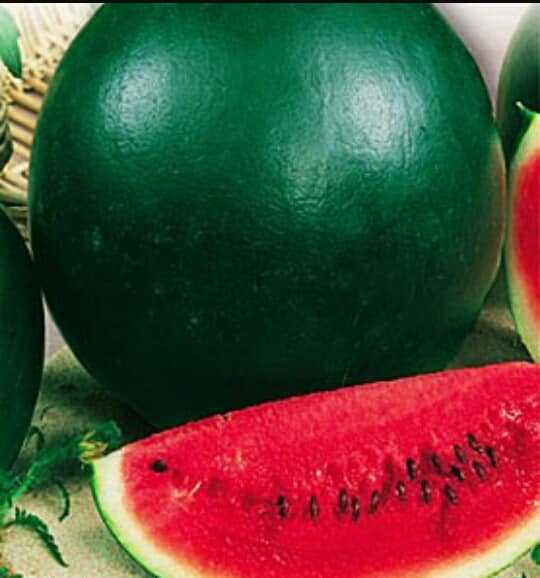
The Berries of the Fire have a rounded shape and are colored bright green. Ripe fruits are gradually covered with dark stripes. The light cannot boast of large watermelons, since they only grow up to 3-4 kilograms. However, 4-5 fruits are imposed on each bush, which makes it possible to collect more than 20 kilograms of the crop.
Sugar
This watermelon is considered a versatile variety as it copes well with cold and arid climates. Therefore, gardeners grow it not only in greenhouses, but also in the open air. However, in greenhouses, Sugar grows faster and bears fruit better.
The fruits are distinguished by an oval shape and a smooth greenish surface.
Many gardeners attribute to the advantages of Sugar its taste, which is distinguished by a pleasant aroma and sweetness. Watermelon berries grow up to five kilograms when grown outdoors. In greenhouses, their weight can reach 7-8 kilograms.
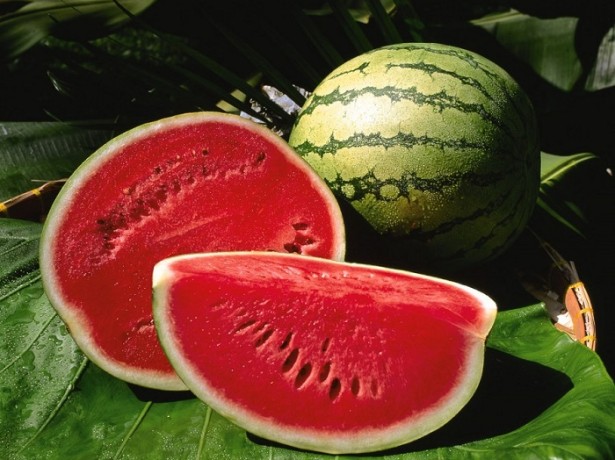
Sowing seeds and growing seedlings
Before you start growing watermelon seedlings, you should familiarize yourself with the peculiarities of planting seeds and their germination before the first shoots appear.
Seed preparation
Only pre-prepared seeds that have been pre-treated should be planted in the soil. When preparing seeds, before planting, they must be warmed up. The procedure is carried out to remove all bacteria and pathogens from the surface of the inoculum. To do the heating, you will have to use special heating devices.
For example, you can put the seeds in the oven for 5-7 minutes.The first few minutes it should be warmed up to 20-30 degrees, after which the heating temperature gradually increases to 60 degrees. During heating, all the seeds are periodically mixed so that they are warmed up more thoroughly.
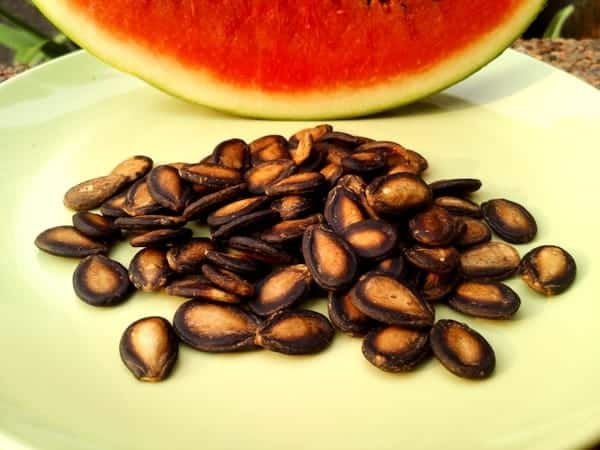
Also, manganese liquid is used to disinfect the inoculum. To create a mixture of 100 milliliters of water, add 2-3 grams of manganese. Then the seeds are placed in the container and soaked in it for about half an hour. Some gardeners during the procedure add wood ash to the solution to speed up the seed germination process. After removing the seeds from the manganese solution, they are washed with running water and dried.
Containers and soil
Experienced gardeners advise, for growing watermelon seedlings, to plant seeds in bulk or peat pots. You can also use cardboard egg trays or plastic cassettes for planting melons and gourds. However, some people use peat pots.
When using such containers in the future, you will not have to engage in picking of the planted plants, since they can be placed in the ground along with the pot.
Having decided on the most suitable container for watermelons, they begin to prepare the soil mixture for planting. Planting seeds should be done in pre-prepared soil filled with nutrients. When creating a soil mixture, humus is added to the ground, which is made from rotted plants or manure. Also, peat is considered an irreplaceable component that is often used to improve soil fertility. It makes the earth looser, due to which moisture penetrates into its upper layers faster.

After preparing the soil, they are engaged in planting seeds. For this, shallow depressions are made in the soil, into which 2-3 seeds are placed. When the seedlings grow up to 5-8 centimeters, they are transplanted into a greenhouse.
Rules for the care of greenhouse watermelons
It is no secret that all planted seedlings must be grown correctly in order to collect large fruits. To do this, you will have to regularly care for watermelons, water and feed the bushes. Also, when leaving, the garter of the seedlings to the supports is mandatory.
Watering frequency
Melons and gourds are distinguished by a complex root system, which allows them to effectively absorb moisture even from the lower layers of the soil. Therefore, do not water the bushes too often. Gardeners recommend moisturizing the area when the leaves begin to wither. When watering, the liquid is poured under the root to protect the upper leaves from water.
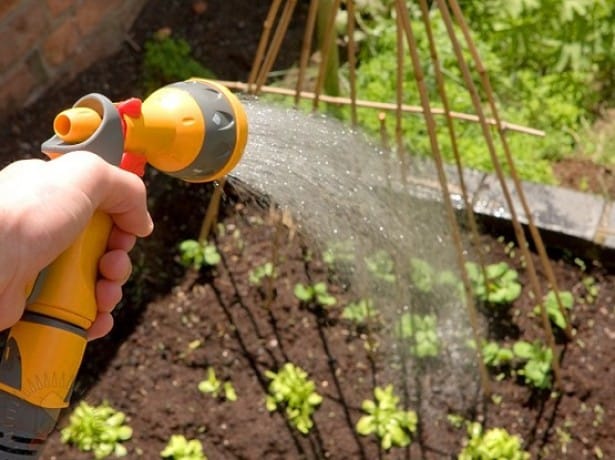
Light and thermal conditions
The amount of light and heat values affect the yield of watermelons. People who work with watermelons are advised to monitor the lighting and climatic conditions in greenhouses. The optimum temperature is considered to be about 25-30 degrees.
The duration of daylight hours should not be less than 12 hours. Therefore, you will have to install lamps near the beds for additional lighting.
Fertilizer
Each bush begins to feed when the height of its stems reaches 20-30 centimeters. The plant grows to this size within a month after transplanting into a greenhouse. At first, only organic fertilizing is added to the ground. The next time the site is fertilized before flowering and the formation of fruits. This time they use mineral dressings in the form of superphosphate and ammonium nitrate.

Formation of melons
The quality and quantity of the crop depends on the formation of the bush. Therefore, it is recommended to familiarize yourself in advance with how to properly form plants in a greenhouse.
When forming watermelons, first pinch the stems above the fifth leaf. After a few days, additional shoots appear in the lower part of the shoots, which must be pinned. Some gardeners cut them out as soon as they appear.Also pruning of shoots on which ovaries have not formed is carried out.
The described pruning scheme will help grow strong bushes on which large and juicy fruits will grow.
Watermelon tying technology
Every gardener should know how to tie up watermelons correctly. The first garter of plants is carried out two weeks after they are planted in the soil. For this, supports are installed along each row, on which the wire is pulled. When the plant grows up to 40 centimeters, it is tied with threads to a wire.

After the formation of the fruit, the garter is repeated. In this case, you will have to hang special nets on the trellis, into which the ripening watermelons are placed.
Harvesting
Watermelons are harvested after they are fully ripe. The maturity of the crop is evidenced by the drying out of the connective lash near the fruits. Also, ripe watermelon berries are covered with dark greenish stripes.The harvested crop is cleaned of dirt, washed, dried and transferred to the cellar for storage.
Conclusion
Everyone can cope with the cultivation of watermelon bushes in greenhouses. To do this, you need to familiarize yourself with the features of planting watermelons and the rules for caring for them.

